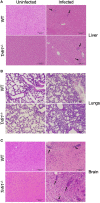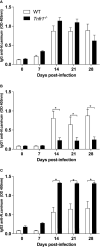TNF-TNFR1 Signaling Enhances the Protection Against Neospora caninum Infection
- PMID: 35071042
- PMCID: PMC8776637
- DOI: 10.3389/fcimb.2021.789398
TNF-TNFR1 Signaling Enhances the Protection Against Neospora caninum Infection
Abstract
Neospora caninum is a protozoan associated with abortions in ruminants and neuromuscular disease in dogs. Classically, the immune response against apicomplexan parasites is characterized by the production of proinflammatory cytokines, such as IL-12, IFN-γ and TNF. TNF is mainly produced during the acute phases of the infections and binds to TNF receptor 1 (CD120a, p55, TNFR1) activating a variety of cells, hence playing an important role in the induction of the inflammatory process against diverse pathogens. Thus, in this study, we aimed to evaluate the role of TNF in cellular and humoral immune responses during N. caninum infection. For this purpose, we used a mouse model of infection based on wildtype (WT) and genetically deficient C57BL/6 mice in TNFR1 (Tnfr1-/-). We observed that Tnfr1-/- mice presented higher mortality associated with inflammatory lesions and increased parasite burden in the brain after the infection with N. caninum tachyzoites. Moreover, Tnfr1-/- mice showed a reduction in nitric oxide (NO) levels in vivo. We also observed that Tnfr1-/- mice showed enhanced serum concentration of antigen-specific IgG2 subclass, while IgG1 production was significantly reduced compared to WT mice, suggesting that TNFR1 is required for regular IgG subclass production and antigen recognition. Based on our results, we conclude that the TNF-TNFR1 complex is crucial for mediating host resistance during the infection by N. caninum.
Keywords: TNF; antibodies; chronic phase; effector molecules; neosporosis.
Copyright © 2022 Ferreira França, Silva, Silva, Ramos, Miranda, Mota, Santiago, Mineo and Mineo.
Conflict of interest statement
The authors declare that the research was conducted in the absence of any commercial or financial relationships that could be construed as a potential conflict of interest.
Figures






References
-
- Barros P. D. S. C., Mota C. M., dos Santos Miranda V., Ferreira F. B., Ramos E. L. P., Santana S. S., et al. . (2019). Inducible Nitric Oxide Synthase Is Required for Parasite Restriction and Inflammatory Modulation During Neospora Caninum Infection. Vet. Parasitol. 276, 108990. doi: 10.1016/j.vetpar.2019.108990 - DOI - PubMed
Publication types
MeSH terms
Substances
LinkOut - more resources
Full Text Sources

